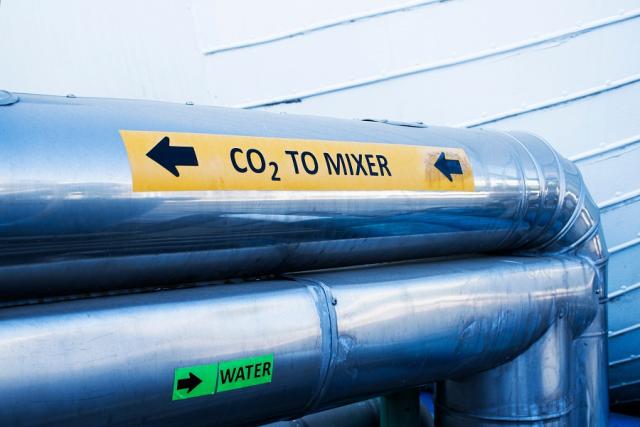
After Exxon Mobil’s deal to buy Denbury, CCS sequesterers and transporters appear to be “leading the dance” in driving carbon capture and sequestration projects, midstream operators and legal experts say. (Source: Shutterstock.com)
Naturally, $4.9 billion gets a lot of attention — but apparently the effect multiples when it’s the price that Exxon Mobil is willing to shell out for smaller, EOR-focused E&P Denbury Inc.
The deal, when closed, will add roughly 47,000 boe/d to Exxon’s portfolio — a minor bump compared to the major’s second-quarter Permian Basin output of 620,000 boe/d.
As analysts have noted, Exxon’s real prize was Denbury’s 1,300 miles of CO2 pipelines and its carbon capture and sequestration (CCS) efforts.
Exxon’s transaction, among others, has generated a quiet consensus: the emerging market for clean-energy midstream is intriguing. For now, the signal for investment and development is slow paced — more akin to a “proceed” on a railroad semaphore than a “…And they’re off!”
Steven B. Huckaby, CEO of Humble Midstream, told Hart Energy the enthusiasm for clean-energy midstream is driving a lot of conversations.
“We’re talking to a lot of people about a lot of things: hydrocarbons, hydrogen and ammonia,” he said. “In most cases, individual emitters are not likely to have enough scale with their volumes to drive CCS projects on their own. We've seen the occasional emitter out there unsuccessfully trying on their own. So it’s mostly the sequesterers and the midstream leading the dance.”
Humble recently sold its stake in an ammonia venture at Corpus Christi with Enbridge Inc. and was replaced in that project by fertilizer Norwegian major Yara. Humble is currently evaluating other options in all aspects of midstream.
And midstream operators and investors are the ones to advance clean energy, from CCS to hydrogen and ammonia, Huckaby contends.
“I like this for the midstream, particularly for operators backed by private equity,” he said. “We’re commercially oriented and comfortable blazing new frontiers. Of course, we’re also fee-for-service guys, so we don’t want to get too far out front, but we do need to be aggressive.”
Huckaby noted two factors in particular that favor private equity-backed midstream. “First, the scale necessary for CCS, hydrogen and ammonia means larger amounts of capital. Scale drives price,” he said. “And second, if you look back on the last few years, a lot of money has been made in our sector developing greenfield business. Money has been made by people not afraid to make a cold call.”
The importance of scale also adds clarity to the nature of midstream CCS development, observed Colleen Jarrott, a partner in the New Orleans office of national law firm Hinshaw & Culbertson who specializes in regulated industries. “In general, there are three parties: the emitter, the transporter and the sequesterer. “Exxon was the emitter and has now become the transporter and soon to be sequesterer. They have the scale to cut out the middle and create a full package.”
Occidental Petroleum is at a similar scale but is approaching carbon emissions through direct air capture technology. That led the company to an August deal to acquire Carbon Engineering Ltd. in a $1.1 billion deal.
Just about everyone else, Jarrott said, “is now thinking, or rethinking, transportation.”
“They are going to the midstreamers. And there is such a spaghetti-bowl of pipe between New Orleans and Houston. The conversations are happening.”
Specific parties and locations are confidential, but Jarrott suggested that the early sense of conversation follows a figurative path from injection well to smokestacks. “Things have been quiet on the emitter side, but deals are in the works,” Jarrott said. “The emitters are the ones being approached. The folks who gobbled up pore space early on are now looking to get CO2 there.”
She also reconfirmed the signal from the big recent deals is more 'steady on' than 'off to the races.' Multi-party transactions are more complicated that bi-lateral deals, so a possible surge in CCS midstream deals would more likely stretch out over months, not weeks.
Recommended Reading
BP’s Kate Thomson Promoted to CFO, Joins Board
2024-02-05 - Before becoming BP’s interim CFO in September 2023, Kate Thomson served as senior vice president of finance for production and operations.
Magnolia Oil & Gas Hikes Quarterly Cash Dividend by 13%
2024-02-05 - Magnolia’s dividend will rise 13% to $0.13 per share, the company said.
TPG Adds Lebovitz as Head of Infrastructure for Climate Investing Platform
2024-02-07 - TPG Rise Climate was launched in 2021 to make investments across asset classes in climate solutions globally.
Air Products Sees $15B Hydrogen, Energy Transition Project Backlog
2024-02-07 - Pennsylvania-headquartered Air Products has eight hydrogen projects underway and is targeting an IRR of more than 10%.
HighPeak Energy Authorizes First Share Buyback Since Founding
2024-02-06 - Along with a $75 million share repurchase program, Midland Basin operator HighPeak Energy’s board also increased its quarterly dividend.





